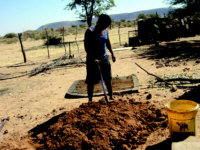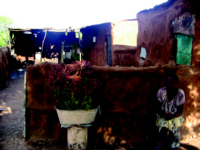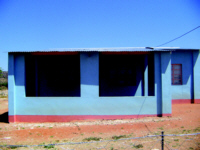Menue
Building Houses in Fransfontein
(Otto /Uirab)
Introduction
Every human being needs a roof over their head. Shelter provides
protection against the sun, wind, rain, cold and heat. It guarantees
safety to humans. It also provides a place to cook, eat and sleep.
There are basically two types of houses in the Fransfontein area, i.e.
traditionally built houses and modern houses.
Traditional Houses
People use many different ways to build traditional houses. The shapes and sizes of the houses depend on the size of the family and the availability of materials. The shapes are usually well structured for future extensions. In the past, all indigenous groups used the same structured traditional houses,
which were small and round in shape, with the roofs made of grass or
mopani wood and the frame made with cow-dung and clay-soil, mixed with
water.
Today, in the Fransfontein area, the structure of the traditional houses has changed and resembles the shapes of the modern brick houses. This fact can be attributed to many factors. According to my research, the most important factor is the use of zinc-plates as roofs nowadays. The shape of the outer walls had to change to accommodate the zinc-roofs. It would have been very difficult to put squared zinc plates on a round house. However, natural building materials are still used to build traditional houses. The materials mainly used are mopani trees, clay-soil and cow-dung which are all readily available. There are different colors of clay-soil which can be used to decorate the houses.
Depending on the size of the house an estimated number of straight
mopane-tree branches are cut. The branches are usually transported by
donkey-cart to the village. A structure is determined, whether it
should be round or square. The corner poles are dug in first, about
50cm deep, and the ones coming in-between at around 20cm. This is done
for a strong foundation.
Cow-dung and clay is mixed with water which provides a nice, sticky plastering result. The mud is plastered smoothly over the structure. In the past, the roofs of the houses were also from natural materials but nowadays, people are using only zinc plates in the Fransfontein area. Clay also has good isolation properties, keeping houses cool in summer and warm in winter.
A traditional house normally consists of the following structures: the veranda, referred to in Khoekhoe as “hob”, the sitting-room, called “!hao-!nâ-oms” in Khoekhoe, sleeping-room, called “//om-!nâ-oms”, the kitchen, called “#û-sâi-!nâ-oms”, and the guest house or “!hao-oms”. There are traditional houses in Fransfontein more than fifty years old which proves how strong and reliable a traditional house can be.
Modern Houses
One of the first modern types of building in Fransfontein was the local
Evangelical Lutheran Church. It was built during the time of Missioner
Heinrich Riechmann. The community and some German soldiers built the
church. The church was inaugurated on 25 March 1900. The material used
was mainly clay. Clay-bricks were made and the plastering was also
clay.
Today, the modern houses are built mainly with cement bricks, cement mortar and concrete. The mixture of concrete is made of sand, cement and broken stones. The roof is made with zinc plates and wooden planks. However, these materials are very expensive and not everybody can afford them. People living in these types of houses are the ones who have jobs and security to pay the rent. In some cases, these houses are built by acquiring loans from banks.
People prefer modern brick houses but due to the high costs involved
they just make traditional houses which are much cheaper. As I have
mentioned before, the materials for the traditional houses are freely
and readily available but for modern houses, one has to buy expensive
materials and transport it to the building place. Further, one has to
pay the people who will build the house. For a small place like
Fransfontein and with a very high unemployment rate this is very hard.
However, the government of the Republic of Namibia has also introduced a housing scheme, called “Build Together”, for low-income earners within the community. Through this program, many families can now own modern houses in Fransfontein.
Conclusion
It is very important in life for a human being to own a house. This is where children are born, raised and cared for, and where a child learns the importance of humanity. I hope every owner knows the value of a home, not a house.

|
| Fig 1: Building the structure of the house |
Traditional Houses
People use many different ways to build traditional houses. The shapes and sizes of the houses depend on the size of the family and the availability of materials. The shapes are usually well structured for future extensions. In the past, all indigenous groups used the same structured traditional houses,

|
| Fig 2: Mixing clay and cow dung |
Today, in the Fransfontein area, the structure of the traditional houses has changed and resembles the shapes of the modern brick houses. This fact can be attributed to many factors. According to my research, the most important factor is the use of zinc-plates as roofs nowadays. The shape of the outer walls had to change to accommodate the zinc-roofs. It would have been very difficult to put squared zinc plates on a round house. However, natural building materials are still used to build traditional houses. The materials mainly used are mopani trees, clay-soil and cow-dung which are all readily available. There are different colors of clay-soil which can be used to decorate the houses.

|
| Fig 3: Traditional house |
Cow-dung and clay is mixed with water which provides a nice, sticky plastering result. The mud is plastered smoothly over the structure. In the past, the roofs of the houses were also from natural materials but nowadays, people are using only zinc plates in the Fransfontein area. Clay also has good isolation properties, keeping houses cool in summer and warm in winter.
A traditional house normally consists of the following structures: the veranda, referred to in Khoekhoe as “hob”, the sitting-room, called “!hao-!nâ-oms” in Khoekhoe, sleeping-room, called “//om-!nâ-oms”, the kitchen, called “#û-sâi-!nâ-oms”, and the guest house or “!hao-oms”. There are traditional houses in Fransfontein more than fifty years old which proves how strong and reliable a traditional house can be.
Modern Houses

|
| Fig 4: Construction of brick house |
Today, the modern houses are built mainly with cement bricks, cement mortar and concrete. The mixture of concrete is made of sand, cement and broken stones. The roof is made with zinc plates and wooden planks. However, these materials are very expensive and not everybody can afford them. People living in these types of houses are the ones who have jobs and security to pay the rent. In some cases, these houses are built by acquiring loans from banks.

|
| Fig 5: Modern house |
However, the government of the Republic of Namibia has also introduced a housing scheme, called “Build Together”, for low-income earners within the community. Through this program, many families can now own modern houses in Fransfontein.
Conclusion
It is very important in life for a human being to own a house. This is where children are born, raised and cared for, and where a child learns the importance of humanity. I hope every owner knows the value of a home, not a house.
Designed with Free CSS Templates